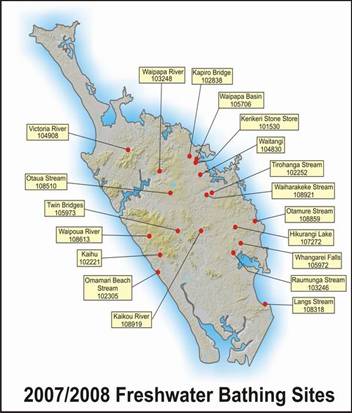Recreational Bathing Water Quality
Within this section…
The Recreational Bathing Water Quality Programme is a joint project run by NRC, in conjunction with Kaipara, Whangarei and the Far North district councils and the Northland District Health Board (DHB). The programme involves sampling water quality at a number of the most popular freshwater and coastal swimming sites around Northland for 12 weeks over the summer months. For results from coastal sites, please refer to the ‘Coast' section of the Annual Monitoring Report.
Freshwater quality in rivers and streams is not always safe for recreational use (such as swimming or contact sports), as waterways can sometimes become contaminated with illness causing bacteria. These bacteria can enter the water after an ‘environmental incident', such as a sewage spill, during periods of prolonged or heavy rainfall, when contaminants off the land (such as livestock effluent or wild animal dung) get washed into waterways or where there is a persistent source of pollution, such as a leaking septic tank.
During the 2007-08 summer season, 19 freshwater swimming sites around Northland were monitored. Samples were collected from each site on a weekly basis and analysed for the pollution indicator bacteria Escherichia coli (E. coli). The methodology used follows that recommended in the ‘Microbiological Water Quality Guidelines for Marine and Freshwater Recreational Areas' developed jointly by MfE and the Ministry of Health (MoH).

The results for each site are compared to the guidelines issued by MfE. Each week, sites are given a grading based on the levels of bacteria present – green for ‘safe for recreational use', orange for ‘caution' or red for ‘unsafe for recreational use'. These gradings and results are posted at the end of each week on the NRC website - http://www.nrc.govt.nz/swimming.
Results are also forwarded to each of the district councils and the DHB on a weekly basis. However, in the event of a ‘caution' or ‘unsafe' result, the relevant district council and DHB is informed of the result within 24 hours of the sample entering the NRC lab. This ensures that follow-up action is swift, for example, further sampling and that warning signs are erected promptly, where necessary, in order to minimise any potential risk to human health.
The table below gives the guideline values for microbiological water quality in relation to recreational bathing and the recommended actions to be taken by district councils.
| E. Coli count (cells/100mL) | Status | Suggested follow up |
| Less than or equal to 260 | Acceptable/Safe |
|
| Greater than 260 but less than or equal to 550 | Alert/Caution |
|
| Greater than 550 | Action/Unsafe |
|
Results 2007-08
The results from 2007-08 show that most freshwater sites were safe for recreational use during dry weather but, after heavy and/or prolonged rainfall, bacterial levels became greatly elevated for several days.
Some sites, such as Otamure Bay Stream, were generally unsafe for recreational use regardless of weather conditions. Other sites, such as Lake Waro, were suitable for recreational use throughout the sampling period. Water quality at Lake Waro has improved over the last two summer seasons since water fowl numbers were reduced.
The table below gives the median E. Coli results for each site for the 2007-08 survey season. Median results give an indication of the average water quality at each site. However, it must be remembered that samples are only taken once a week for a 12 week period from each site and the result on the day can be greatly influenced by a single rainfall event.
| District | Site Name | Site Number | Median Result |
| WDC | Otamure Bay Stream | 108859 | 1467 |
| WDC | Lake Waro | 107272 | 31 |
| WDC | Whangarei Falls | 105972 | 624 |
| WDC | Raumanga Stream | 103246 | 529 |
| WDC | Kaikou River | 108919 | 413 |
| WDC | Langs Beach Stream | 108318 | 842 |
| FNDC | Waiharakeke | 108921 | 569 |
| FNDC | Waipapa River Basin | 105706 | 74 |
| FNDC | Kerikeri Stone Store | 101530 | 175 |
| District | Site Name | Site Number | Median Result |
| FNDC | Waitangi @ Lily Pond | 104830 | 292 |
| FNDC | Tirohanga Stream | 102252 | 231 |
| FNDC | Kapiro Stream (Purerua Rd) | 102838 | 272 |
| FNDC | Waipapa River (Puketi) | 103248 | 82 |
| FNDC | Waipoua River | 108613 | 74 |
| FNDC | Twin Bridges | 105973 | 231 |
| FNDC | Otaua stream | 108510 | 271 |
| FNDC | Victoria River | 104908 | 288 |
| KDC | Kaihu River | 102221 | 86 |
| KDC | Omamari Beach Stream | 102305 | 218 |
Suitability for Recreation Grade
Using the guidelines developed by MfE, an interim Suitability for Recreation Grade (SFRG) can be given to all sites with at least five seasons survey data. Although these grades provide an indication of a sites general suitability for use, the grading system has not been designed to take into account Northland's high rainfall. This means that the interim grades tend to overstate the health risks at some sites, for example, despite Lake Waro returning consistently good water quality results for the last two summer seasons, its interim grade is still ‘poor' based on the guidelines.
